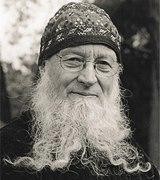Thanks for your visit!
Please note: this is not an official MySpace of Terry Riley: this MySpacePage is lovingly made by The Terry Riley Italian Fan Club. Any help or comments are accepted.
Biography
Born in Colfax, California, Riley studied at Shasta College, San Francisco State University, and the San Francisco Conservatory before earning an MA in composition at the University of California, Berkeley, studying with Seymour Shifrin. His most influential teacher, however, was the late Pandit Pran Nath, a master of Indian classical voice, who also taught La Monte Young and Marian Zazeela.
Riley made numerous trips to India over the course of their association to study and to accompany him on tabla, tambura, and voice. Throughout the sixties he travelled frequently around Europe as well, taking in musical influences and supporting himself by playing in piano bars, until he joined the Mills College faculty in 1971 to teach Indian classical music.
Also during the sixties were the famous All-Night Concerts during which Riley performed mostly improvised music from evening until sunrise, using an old organ harmonium and tape-delayed saxophone. When he finally wanted a break, after hours of playing, he played back looped saxophone fragments recorded throughout the evening. For several years he continued to put on these concerts, to which people came with sleeping bags, hammocks, and their whole families.
Riley is also currently performing and teaching both as an Indian raga vocalist and as a solo pianist.
Music
While his early endeavours were influenced by Stockhausen, Riley changed direction after first encountering La Monte Young, whose Theater of Eternal Music he later performed in from 1965-66.
Riley has referred to Young as "the freakiest guy I have ever met in my life" stating that it was Young's ideas that were at the heart of minimalism, though more composers have come to name Riley himself as an influence.
The String Quartet (1960) was Riley's first work in this new style; it was followed shortly after by a string trio, in which he first latched on to the repetitive short phrases that he (and minimalism) are now known for.
His music is usually based on improvising through a series of modal figures of different lengths, such as in In C and the Keyboard Studies.
In C (1964) is probably Riley's best-known work and one that brought the minimalistic music movement to prominence. Its first performance was given by Steve Reich, Jon Gibson, Pauline Oliveros, and Morton Subotnick, among others, and it has influenced their work and that of many others, including John Adams and Philip Glass. Its form was an innovation: the piece consists of 53 separate modules of roughly one measure apiece, each containing a different musical pattern but each, as the title implies, in C. One performer beats a steady stream of Cs on the piano to keep tempo. The others, in any number and on any instrument, perform these musical modules following a few loose guidelines, with the different musical modules interlocking in various ways as time goes on.
The Keyboard Studies are similarly structured – a single-performer version of the same concept.
This format, with a collection of minimal musical elements coming together to form a complex and cohesive whole, launched a movement that was a step away from the increasing academicism in western classical music: the minimalistic movement.
Riley often further denied strict structure by introducing improvisational elements into his compositions (though he had long been improvising in solo performance); one of the primary pieces to use this approach was his A Rainbow In Curved Air (1968). This work and Poppy Nogood and the Phantom Band, its companion piece on a recording issued in 1969, were intended to give a necessarily truncated impression of the sound of Riley's all-night concerts.
For a time Riley stopped notating his works at all, focusing on Indian classical music and solo performance. Working with the Kronos Quartet has led him back to more structured, notatable music, but improvisatory elements remain an important part even of the works composed for them.
Being on the leading edge of music was nothing new for Riley. Already in the 1950s he was working with tape loops, a technology then in its infancy, and he has continued manipulating tapes to musical effect, both in the studio and in live performance, throughout his career.
He has composed in just intonation as well as microtonal pieces.
This is not an official MySpace of Terry Riley: this MySpacePage is lovingly made by The Terry Riley Italian Fan Club
Any help or comments are accepted.
I edited this profile with Thomas' Myspace Editor V4.4
